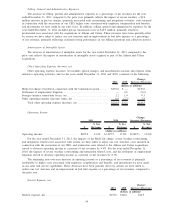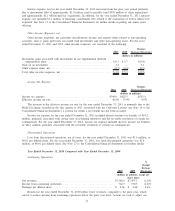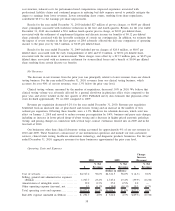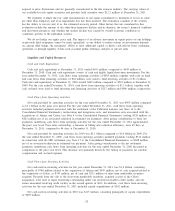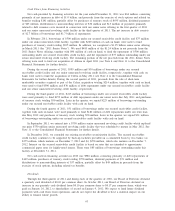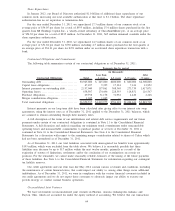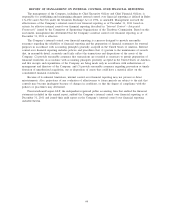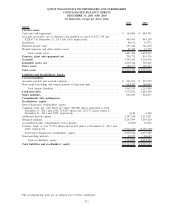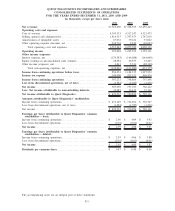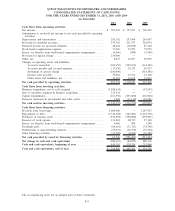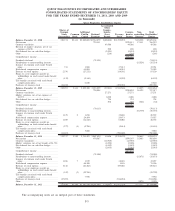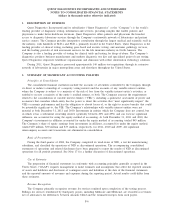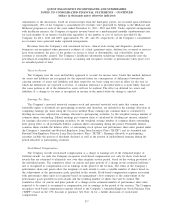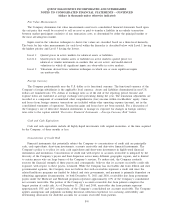Quest Diagnostics 2011 Annual Report Download - page 71
Download and view the complete annual report
Please find page 71 of the 2011 Quest Diagnostics annual report below. You can navigate through the pages in the report by either clicking on the pages listed below, or by using the keyword search tool below to find specific information within the annual report.with our joint ventures are conducted at arm’s length, reflecting current market conditions and pricing. Total net
revenues of our unconsolidated joint ventures equal less than 6% of our consolidated net revenues. Total assets
associated with our unconsolidated joint ventures are less than 2% of our consolidated total assets. We have no
material unconditional obligations or guarantees to, or in support of, our unconsolidated joint ventures and their
operations.
Requirements and Capital Resources
We estimate that we will invest between $225 million to $250 million during 2012 for capital expenditures,
including assets under capitalized leases, to support and expand our existing operations, principally related to
investments in information technology, equipment, and facility upgrades. We expect to fund the repayment of our
short-term borrowings and the current portion of our long-term debt using cash on hand and existing credit
facilities.
As of December 31, 2011, $1.2 billion of borrowing capacity was available under our existing credit
facilities, consisting of $440 million available under our secured receivables credit facility and $750 million
available under our senior unsecured revolving credit facility.
We believe the banks participating in our various credit facilities are predominantly highly-rated banks, and
that the borrowing capacity under the credit facilities described above is currently available to us. Should one or
several banks no longer participate in either of our credit facilities, we would not expect it to impact our ability
to fund operations. We expect that we will be able to replace our existing secured receivable credit facility with
alternative arrangements prior to its expiration.
We believe that cash and cash equivalents on-hand and cash from operations, together with our borrowing
capacity under our credit facilities, will provide sufficient financial flexibility to meet seasonal working capital
requirements, capital expenditures, debt service requirements and other obligations, cash dividends on common
shares, share repurchases and additional growth opportunities for the foreseeable future. We believe that our
credit profile should provide us with access to additional financing, if necessary, to fund growth opportunities
that cannot be funded from existing sources.
Outlook
As discussed in the Overview, despite the continued consolidation among healthcare insurers, and their
continued efforts to reduce reimbursement for providers of diagnostic testing, and the general economic
conditions, we believe that the underlying fundamentals of the diagnostic testing industry will continue to
improve and that over the long-term the industry will continue to grow. As the world’s leading provider of
diagnostic testing, information and services, we believe we are well positioned to benefit from the growth
expected in our industry.
We believe our efforts to reduce operating costs, focus on delivering a superior patient experience and Six
Sigma quality, as well as the investments we are making in sales, service, science and information technology
will further differentiate us over the long-term and strengthen our industry leadership position.
Our strong cash generation, existing credit facilities and access to additional financing position us well to
take advantage of growth opportunities.
Inflation
We believe that inflation generally does not have a material adverse effect on our results of operations or
financial condition because the majority of our contracts are short term.
Impact of New Accounting Standards
In May 2011, the Financial Accounting Standards Board (“FASB”) issued an amendment to the accounting
standards related to fair value measurements. In June 2011, the FASB issued an amendment to the accounting
standards related to the presentation of comprehensive income. In September 2011, the FASB issued an
amendment to the accounting standards related to the testing of goodwill for impairment. The impact of these
accounting standards is discussed in Note 2 to the Consolidated Financial Statements.
65



